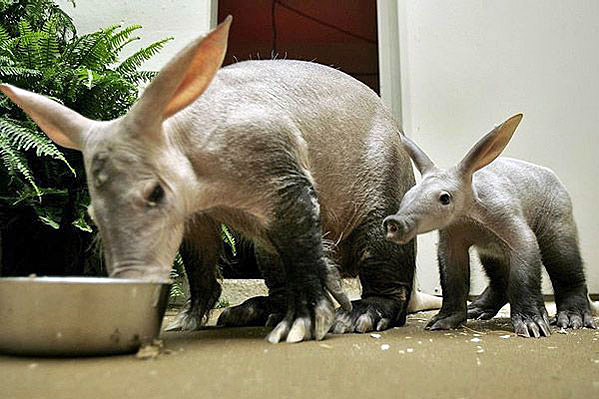It is sometimes called "antbear", "anteater", "Cape anteater" (after the Cape of Good Hope), "earth hog" or "earth pig". The word "aardvark" is famous for being one of the first entries to appear in many encyclopaedias and even abridged dictionaries. The name comes from the Afrikaans/Dutch[3] for "earth pig" or "ground pig" (aarde earth/ground, varken pig), because early settlers from Europe thought it resembled a domesticated pig. However, the aardvark is not closely related to the pig; rather, it is the sole recent representative of the obscure mammalian order Tubulidentata, in which it is usually considered to form a single variable species of the genus Orycteropus, coextensive with the family Orycteropodidae. The aardvark is not closely related to the South American anteater, despite sharing some characteristics and a superficial resemblance.[4] The closest living relatives of the aardvark are the elephant shrews, along with the sirenians, hyraxes, tenrecs, and elephants. Together, these animals form the superorder Afrotheria.
Interesting eh?
The baby is like Sid in ice age

One of the most distinctive characteristics of the Tubulidentata is (as the name implies) their teeth. Instead of having a pulp cavity, each tooth has a cluster of thin, upright, parallel tubes of vasodentin (a modified form of dentine), with individual pulp canals, held together by cementum. The teeth have no enamel coating and are worn away and regrow continuously. The aardvark is born with conventional incisors and canines at the front of the jaw, which fall out and are not replaced. Adult aardvarks only have cheek teeth at the back of the jaw, and have a dental formula of: Upper: 0.0.2-3.3, lower: 0.0.2.3
Genetically speaking, the aardvark is a living fossil, as its chromosomes are highly conserved, reflecting much of the early eutherian arrangement before the divergence of the major modern taxa.[5]
The aardvark is vaguely pig-like in appearance. Its body is stout with an arched back and is sparsely covered with coarse hairs. The limbs are of moderate length. The front feet have lost the pollex (or 'thumb')
